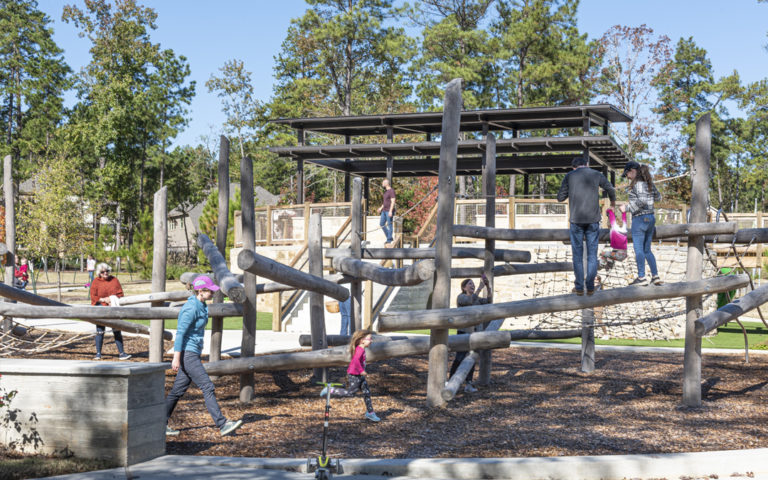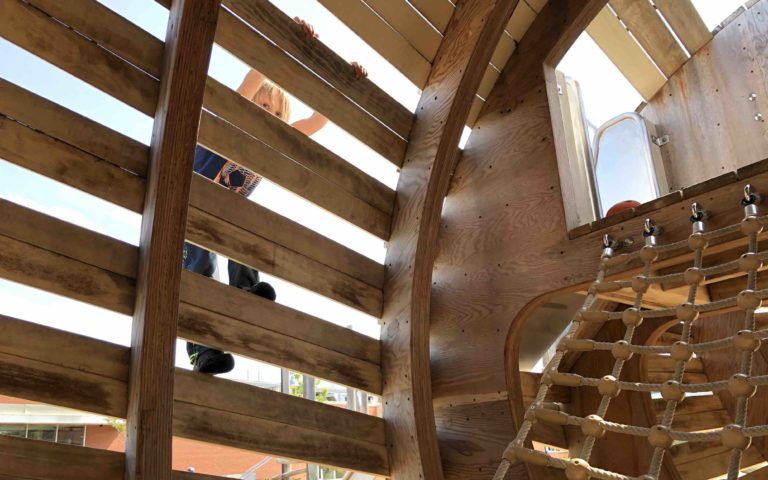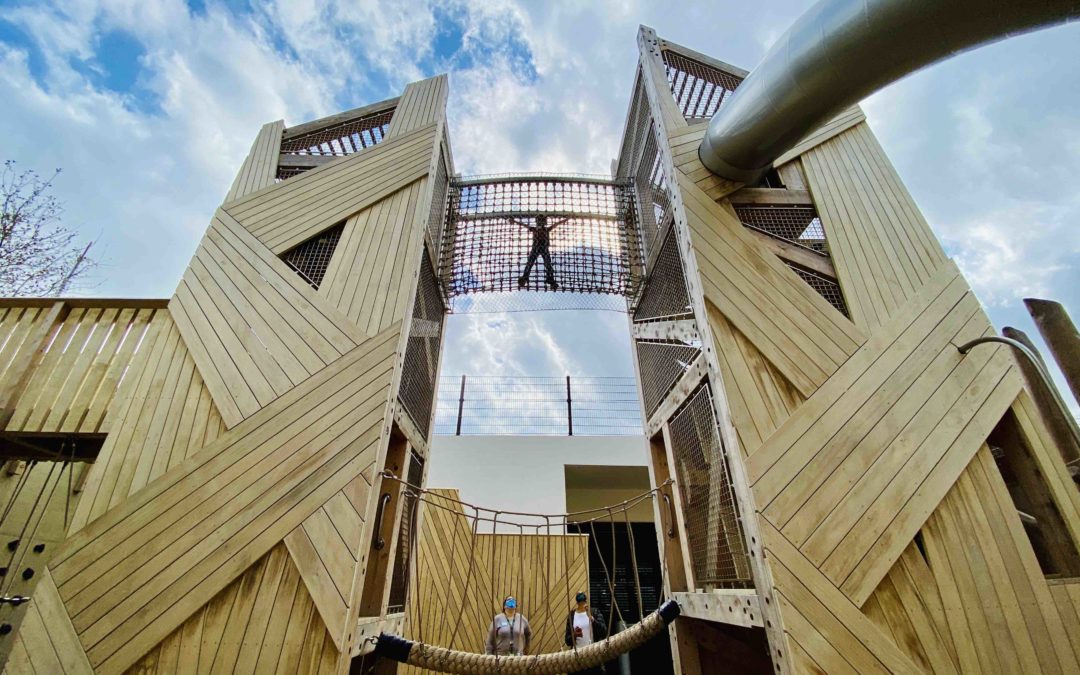
8 Months In: How does a global pandemic impact playground design?
by Nathan Schleicher, Playground Designer
Photo credit (above): Georgetown Day School
In our list of verbs used to describe play structures, we might mention sliding, swinging, balancing, etc. – but what about social distancing? The question must be explored. What does and does not change about playgrounds in a post-COVID-19 world? How does a virus impact the future of play?
I am going to leave those questions for a moment for a note about my dad. He loves this quote by Martin Luther: “Even if I knew that tomorrow the world would go to pieces, I would still plant my apple tree.” We unpacked that quote together early on during the pandemic. It was especially helpful. Over the months, we have talked a lot about simultaneously being very present in today’s moment as well as the “apple trees” that we plant in the spirit of hope. I am grateful that designing play spaces is one of those apple seeds that I get to sow daily.
Now back to the questions. What changes about playground design, and what does not?
Design Change #1 – Circulation through a play space should be as open-ended and multi-directional as possible.
Your traditional neighborhood park has a predictable pattern to its layout and design. A destination element is surrounded by some secondary pieces like swings and spinners. Likely the main feature is a “post & deck” style structure. These often function as highly directional structures with a majority of circulation paths pointing activity toward the “arrival point” of a big slide at the top.
I have spent a lot of time on these types playgrounds with my own kids. Recently they all have had a periphery of stressed out parents reluctant to wade into the congested play space, calling to their children to keep their distance. In COVID times, parents are understandably anxious about a bottleneck of clamouring kids at the top deck.
It doesn’t have to be this way. We should boldly de-prescribe paths of play circulation. This not only benefits our concerns about physical distancing, but adds dimensionality to the post-pandemic child’s play experience as well. Playgrounds should be designed with an open-ended fluidity in mind. They need multiple routes to move between layers of activity nodes.
Though Earthscape already champions non-prescriptive play, this concept has been reinforced and reprioritized to the Nth degree these last few months. Designers should take note of play circulation of the entire site and design to remove congestion.
Design Change #2 – Design for adults to play too.
Watching parents and caregivers at typical playgrounds has been revealing. Adults didn’t want their kids playing too closely with others, yet were unlikely to fill the social-play gap by participating with them in play.
At less ‘standard’ playgrounds, I observed parents interacting with their kids very differently. Recent post-occupancy evaluations I did on our playgrounds at David Hamilton and Gordon Weeden are worth noting. David Hamilton is a bustling destination park outside a community centre. Gordon Weeden is a tiny pocket park hidden along a nature trail that only the locals know exists. At both parks, I observed family units actively playing together. I nearly chalked it up to social distancing as a family unity, but why was this only happening in the more unique contexts?
Here is the pattern: First, kids were getting engaged. They were creative and experimenting with how to move themselves on and through these unusual play features. Then the adults took a turn. They couldn’t help but become curious participants themselves. They were equally determined to figure out how to reach the top of the play sculpture, the boulder between the notched logs, or swoop down the absurdly wide hill slide. The refreshingly unexpected nature of the playground transformed families into an ensemble of explorers and adventurers.
The pandemic has made it really easy to identify this play pattern of parents and caregivers engaged by non-typical play structures. Similar to the way that Pixar’s storytelling style appeals equally to children and adults, we can create playscapes with a design story that appeals to the whole family. To accomplish this, we need to be asking “Are the routes and play moments overly simple or obvious? Does this inspire curiosity for all ages? How might a child AND adult play through the structure together?”
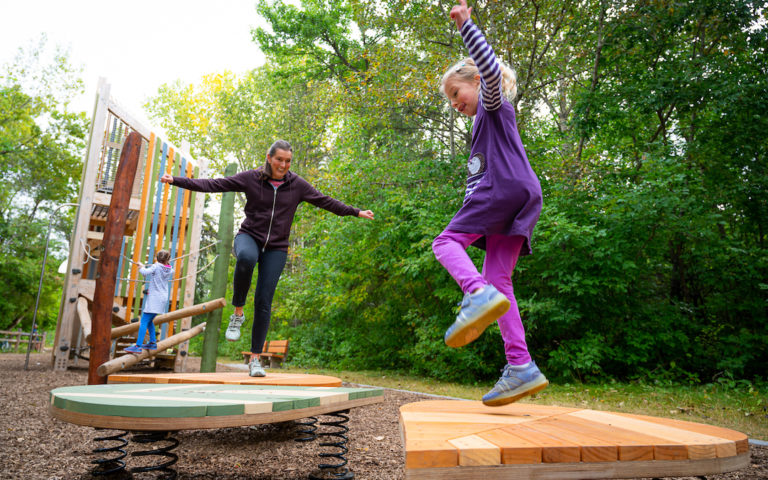
Parents and kids playing together at Sir Wilfrid Laurier Park, Edmonton, AB
Design Change #3 – Playgrounds can be for more than just play.
How can play environments be used for alternative purposes such as art display, concerts, heritage activities, and education. As the school year ramps up and we are programming more outdoor time, let’s consider how a playscape can be designed to double as an environment for learning.
To start, we should dust off and re-think the old ‘outdoor classroom’ model. It typically includes a collection of stumps or boulders arranged in a semicircle with an obvious ‘front.’ What happens when the sun moves? Adjust your ‘chair?’ How physically comfortable is that space? Outside of a formal class, can that valuable location be used for another function?
Wanuskewin Heritage Park, a project located on Indigenous land, is an example where the design brief was clear: every play area should contain a simultaneous opportunity for gathering, teaching, and sharing stories. People can gather under or on a log nest (perhaps draped with fabric for a fun sense of enclosure?) The inside of a play tower can be transformed into a well shaded small-group activity space. In combination, play features could create the spatial architecture of an amphitheatre or have the communal function of a campfire circle.
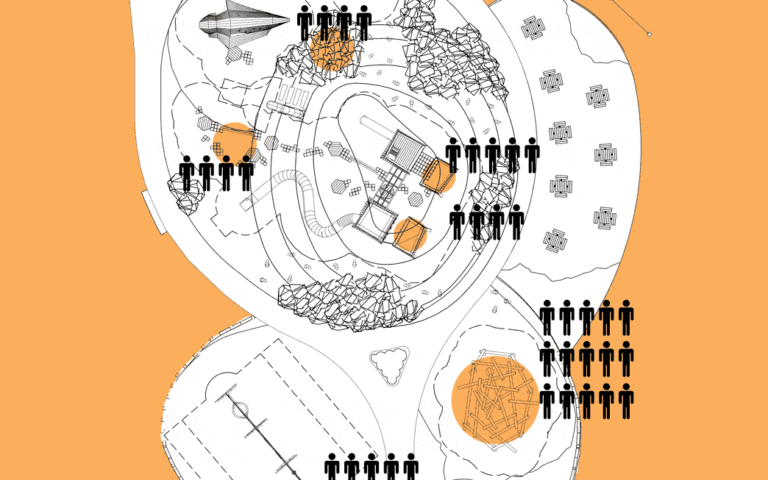
Wanuskewin Heritage Park playground gathering spaces map
What does not change?
Consider that playgrounds are a long term investment. A city needs a popular playground to have a 20 to 30 year life-span. Also, due to the nature and scale of the unique projects we collaborate on, many playgrounds we are designing today won’t be built for at least a year.
For these reasons, I am trying to discern the long view when asked “how does the global pandemic impact playground design?” As we explore this question, it would be a tragedy to abandon the foundational knowledge we have about children’s behaviours and needs. What is important about a play space to children and families (challenge, physicality, social play, imagination, etc.) will always be of utmost importance. Most things should not change.
In Summary
We should approach each playground like Luther’s apple tree.
A post pandemic world will need great playgrounds that do not prioritize social distance over social cohesion. Parks have always been the community nodes that bring neighbours together. They will be the medicine we need after this collective trauma of isolation and anxiety .
Right now I would suggest that parents identify playgrounds made of natural materials (current research shows a lower risk of viral spread). Find places with diverse styles of play equipment that foster non-prescriptive circulation and creative curiosity.
I challenge cities and landscape architects to take inventory of their playgrounds and strive to offer a diversity of play equipment. Be inspired to learn from this moment to improve and transform the state of play for the future. This year has made clear the value of hiking trails, nature conservancies, campgrounds, and city parks and playgrounds. Let’s continue to create profound and positive investments in our shared outdoor spaces.

